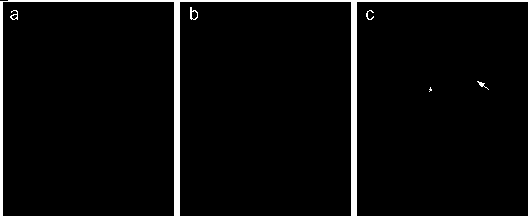Immunofluorescence double labeling method based on same species source first antibody
An immunofluorescence and double labeling technology, applied in the fields of biomedicine and biotechnology, to avoid cross-reaction, avoid immune cross-reaction, and solve the limited source of antibody species
- Summary
- Abstract
- Description
- Claims
- Application Information
AI Technical Summary
Problems solved by technology
Method used
Image
Examples
Embodiment l
[0034] Embodiment 1: The co-expression of TH (A protein) and P75 (B protein) was detected by the immunofluorescence double-labeling technique described in the present invention, and the primary antibodies used were all rabbit-derived , including the following steps:
[0035] (1) Determine the minimum working concentration of rabbit anti-TH antibody:
[0036] (a) Flat-frozen tissue sections of the coeruleus coeruleus in the midbrain of neonatal mice were washed in 0.01 mol / L PBS three times for 5 minutes each time;
[0037] (b) Add normal goat serum blocking solution and incubate in a humid box at 37°C for 60 minutes. Pay attention to keep the sample moist, and be sure to avoid drying the tissue slices, otherwise a high background will be produced;
[0038] (c) According to the concentration recommended in the instruction manual of rabbit anti-TH antibody (Sigma, Cat. No. T-8700), dilute the antibody in a two-fold gradient with antibody diluent (containing 1% BSA and 0.3% T...
Embodiment 2
[0055] Example 2: The cultured neural stem cell slides were detected by the immunofluorescence double labeling technique of the present invention to detect the co-expression of Ki67 (A protein) and BrdU (B antigen). The primary antibodies used were all mouse-derived, including the following steps:
[0056] (1) Determine the minimum working concentration of mouse anti-Ki67 antibody:
[0057] (a) The slides of cultured neural stem cells were fixed in 4% paraformaldehyde for 20 minutes, and washed three times with 0.01 mol / L PBS for 5 minutes each time;
[0058] (b) Add normal goat serum blocking solution and incubate in a humid box at 37°C for 30 minutes;
[0059] (c) According to the recommended concentration of the mouse anti-Ki67 antibody (Abcam, Cat. No. ab6526), use the antibody diluent to dilute the antibody in a two-fold gradient. The specific dilution ratios are 1:200, 1:400, 1:800, 1:1500, 1:3000, add to the cell slides to be tested, and incubate at 4°C for 24 hour...
PUM
 Login to View More
Login to View More Abstract
Description
Claims
Application Information
 Login to View More
Login to View More - R&D
- Intellectual Property
- Life Sciences
- Materials
- Tech Scout
- Unparalleled Data Quality
- Higher Quality Content
- 60% Fewer Hallucinations
Browse by: Latest US Patents, China's latest patents, Technical Efficacy Thesaurus, Application Domain, Technology Topic, Popular Technical Reports.
© 2025 PatSnap. All rights reserved.Legal|Privacy policy|Modern Slavery Act Transparency Statement|Sitemap|About US| Contact US: help@patsnap.com


